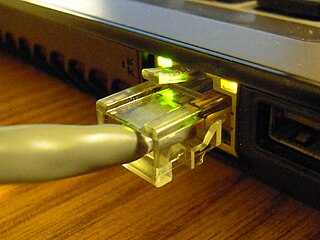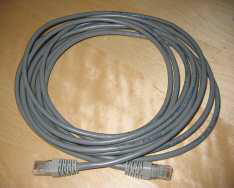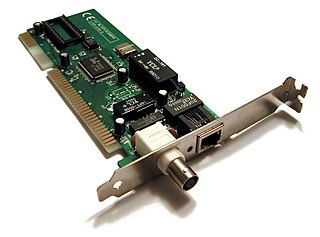
Ethernet is a family of wired computer networking technologies commonly used in local area networks (LAN), metropolitan area networks (MAN) and wide area networks (WAN). It was commercially introduced in 1980 and first standardized in 1983 as IEEE 802.3. Ethernet has since been refined to support higher bit rates, a greater number of nodes, and longer link distances, but retains much backward compatibility. Over time, Ethernet has largely replaced competing wired LAN technologies such as Token Ring, FDDI and ARCNET.

IEEE 802 is a family of Institute of Electrical and Electronics Engineers (IEEE) standards for local area networks (LANs), personal area networks (PANs), and metropolitan area networks (MANs). The IEEE 802 LAN/MAN Standards Committee (LMSC) maintains these standards. The IEEE 802 family of standards has had twenty-four members, numbered 802.1 through 802.24, with a working group of the LMSC devoted to each. However, not all of these working groups are currently active.

A wireless network is a computer network that uses wireless data connections between network nodes. Wireless networking allows homes, telecommunications networks, and business installations to avoid the costly process of introducing cables into a building, or as a connection between various equipment locations. Admin telecommunications networks are generally implemented and administered using radio communication. This implementation takes place at the physical level (layer) of the OSI model network structure.

10BASE2 is a variant of Ethernet that uses thin coaxial cable terminated with BNC connectors to build a local area network. During the mid to late 1980s, this was the dominant 10 Mbit/s Ethernet standard.

Ethernet over twisted-pair technologies use twisted-pair cables for the physical layer of an Ethernet computer network. They are a subset of all Ethernet physical layers.
A network switch is networking hardware that connects devices on a computer network by using packet switching to receive and forward data to the destination device.

Network topology is the arrangement of the elements of a communication network. Network topology can be used to define or describe the arrangement of various types of telecommunication networks, including command and control radio networks, industrial fieldbusses and computer networks.
In radio communication, a transceiver is an electronic device which is a combination of a radio transmitter and a receiver, hence the name. It can both transmit and receive radio waves using an antenna, for communication purposes. These two related functions are often combined in a single device to reduce manufacturing costs. The term is also used for other devices which can both transmit and receive through a communications channel, such as optical transceivers which transmit and receive light in optical fiber systems, and bus transceivers which transmit and receive digital data in computer data buses.

Wi-Fi is a family of wireless network protocols based on the IEEE 802.11 family of standards, which are commonly used for local area networking of devices and Internet access, allowing nearby digital devices to exchange data by radio waves. These are the most widely used computer networks, used globally in home and small office networks to link devices and to provide Internet access with wireless routers and wireless access points in public places such as coffee shops, hotels, libraries, and airports.
In the seven-layer OSI model of computer networking, the physical layer or layer 1 is the first and lowest layer: the layer most closely associated with the physical connection between devices. The physical layer provides an electrical, mechanical, and procedural interface to the transmission medium. The shapes and properties of the electrical connectors, the frequencies to transmit on, the line code to use and similar low-level parameters, are specified by the physical layer.

In IEEE 802 LAN/MAN standards, the medium access control (MAC), also called media access control, is the layer that controls the hardware responsible for interaction with the wired or wireless transmission medium. The MAC sublayer and the logical link control (LLC) sublayer together make up the data link layer. The LLC provides flow control and multiplexing for the logical link, while the MAC provides flow control and multiplexing for the transmission medium.

A network interface controller is a computer hardware component that connects a computer to a computer network.
Wireless local loop (WLL) is the use of a wireless communications link as the "last mile / first mile" connection for delivering plain old telephone service (POTS) or Internet access to telecommunications customers. Various types of WLL systems and technologies exist.
Cisco Inter-Switch Link (ISL) is a Cisco proprietary link layer protocol that maintains VLAN information in Ethernet frames as traffic flows between switches and routers, or switches and switches. ISL is Cisco's VLAN encapsulation protocol and is supported only on some Cisco equipment over the Fast and Gigabit Ethernet links. It is offered as an alternative to the IEEE 802.1Q standard, a widely used VLAN tagging protocol, although the use of ISL for new sites is deprecated by Cisco.

Netopia, Inc., formerly Farallon Computing, Inc., was an American computer networking company that produced a wide variety of products including bridges, repeaters and switches, and in their later Netopia incarnation, modems, routers, gateways, and Wi-Fi devices. The company also produced the NBBS and, as Farallon, Timbuktu remote administration software, as well as the MacRecorder, the first audio capture and manipulation products for the Macintosh. Farallon originated several notable technologies, including:

A computer network is a set of computers sharing resources located on or provided by network nodes. Computers use common communication protocols over digital interconnections to communicate with each other. These interconnections are made up of telecommunication network technologies based on physically wired, optical, and wireless radio-frequency methods that may be arranged in a variety of network topologies.
In audio and broadcast engineering, audio over Ethernet (AoE) is the use of an Ethernet-based network to distribute real-time digital audio. AoE replaces bulky snake cables or audio-specific installed low-voltage wiring with standard network structured cabling in a facility. AoE provides a reliable backbone for any audio application, such as for large-scale sound reinforcement in stadiums, airports and convention centers, multiple studios or stages.
Ethernet in the first mile (EFM) refers to using one of the Ethernet family of computer network technologies between a telecommunications company and a customer's premises. From the customer's point of view, it is their first mile, although from the access network's point of view it is known as the last mile.
In computer networking, an Ethernet frame is a data link layer protocol data unit and uses the underlying Ethernet physical layer transport mechanisms. In other words, a data unit on an Ethernet link transports an Ethernet frame as its payload.
NEARnet was an innovative high-speed regional network for education, research and development, established in 1988 by a consortium led by Boston University, Harvard University, and MIT. It was a precursor to the commercial internet, formed after DARPA announced plans to dismantle the ARPANET. ARPANET then accounted for 71 of the consortium's 258 host connections.










